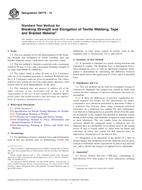Potrebujeme váš súhlas na využitie jednotlivých dát, aby sa vám okrem iného mohli ukazovať informácie týkajúce sa vašich záujmov. Súhlas udelíte kliknutím na tlačidlo „OK“.
ASTM D2261-13
Standard Test Method for Tearing Strength of Fabrics by the Tongue (Single Rip) Procedure (Constant-Rate-of-Extension Tensile Testing Machine)
Automaticky preložený názov:
Štandardná skúšobná metóda pre Trhanie silu textílií na jazyku (Single Rip) Postup (Constant-Rate-of-Extension ťahu skúšobný stroj)
NORMA vydaná dňa 1.1.2013
Informácie o norme:
Označenie normy: ASTM D2261-13
Poznámka: NEPLATNÁ
Dátum vydania normy: 1.1.2013
Kód tovaru: NS-19835
Počet strán: 6
Približná hmotnosť: 18 g (0.04 libier)
Krajina: Americká technická norma
Kategória: Technické normy ASTM
Kategórie - podobné normy:
Anotácia textu normy ASTM D2261-13 :
Keywords:
fabric, strength, tearing tongue, ICS Number Code 59.080.30 (Textile fabrics)
Doplňujúce informácie
| Significance and Use | ||||||||||||||||
|
5.1 This test method is considered satisfactory for acceptance testing of commercial shipments since current estimates of between-laboratory precision are acceptable, and the test method is used extensively in the trade for acceptance testing. 5.1.1 In case of a dispute arising from differences in reported test results when using this test method for acceptance testing of commercial shipments, the purchaser and the supplier should conduct comparative tests to determine if there is a statistical bias between their laboratories. Competent statistical assistance is recommended for the investigation of bias. As a minimum, the two parties should take a group of test specimens that are as homogeneous as possible and that are from a lot of fabric of the type in question. Test specimens then should be randomly assigned in equal numbers to each laboratory for testing. The average results from the two laboratories should be compared using the appropriate statistical analysis and an acceptable probability level chosen by the two parties before testing is begun. If a bias is found, either its cause must be found and corrected, or the purchaser and the supplier must agree to interpret future test results with consideration to the known bias. 5.2 The force registered in a tear test is irregular, and as a consequence, empirical methods have had to be developed to obtain usable values related to tear strength. In spite of the empirical nature of the reported values, the values are considered to reflect comparative performance of similar fabrics tested and measured in the same way. No known procedure is available that can be used with all fabrics to determine the minimum tearing strength. 5.3 Depending on the nature of the specimen, the data recording devices will show the tearing force in the form of a peak or peaks. The highest peaks appear to reflect the strength of the yarn components, fiber bonds, or fiber interlocks, individually or in combination, needed to stop a tear in a fabric of the same construction. The valleys recorded between the peaks have no specific significance. The minimum tearing force, however, is indicated to be above the lowest valleys. 5.4 Most textile fabrics can be tested by this test method. Some modification of clamping techniques may be necessary for a given fabric due to its structure. Strong fabrics or fabrics made from glass fibers usually require special adaptation to prevent them from slipping in the clamps or being damaged as a result of being gripped in the clamps. 5.5 The CRE-type tensile testing machine has become the preferred test apparatus for determining tongue tearing strength. It is recognized that some constant-rate-of-traverse-type (CRT) tensile testing machines continue to be used. Consequently, these test instruments may be used when agreed upon between the purchaser and the supplier. The conditions for use of the CRT-type tester are included in 1.1 This test method covers the measurement of the tearing strength of textile fabrics by the tongue (single rip) procedure using a recording constant-rate-of-extension-type (CRE) tensile testing machine. 1.1.1 The CRE-type tensile testing machine has become the preferred test apparatus for determining tongue tearing strength. It is recognized that some constant-rate-of-traverse-type (CRT) tensile testing machines continue to be used. As a consequence, these test instruments may be used when agreed upon between the purchaser and the supplier. The conditions for use of the CRT-type tensile tester are included in 1.2 This test method applies to most fabrics including woven fabrics, air bag fabrics, blankets, napped fabrics, knit fabrics, layered fabrics, pile fabrics and non-wovens. The fabrics may be untreated, heavily sized, coated, resin-treated, or otherwise treated. Instructions are provided for testing specimens with or without wetting. 1.3 Tear strength, as measured in this test method, requires that the tear be initiated before testing. The reported value obtained is not directly related to the force required to initiate or start a tear. 1.4 Two calculations for tongue tearing strength are provided: the single-peak force and the average of five highest peak forces. 1.5 The values stated in either SI units or inch-pound units are to be regarded as the standard. The inch-pound units may be approximate. 1.6 This standard does not purport to address all of the safety concerns, if any, associated with its use. It is the responsibility of the user of this standard to establish appropriate safety and health practices and determine the applicability of regulatory limitations prior to use. |
||||||||||||||||
| 2. Referenced Documents | ||||||||||||||||
|
Podobné normy:
Historická
1.2.2012
Historická
1.2.2014
Historická
1.5.2011
Historická
1.5.2011
Historická
1.7.2013
Historická
1.6.2011
Odporúčame:
Aktualizácia zákonov
Chcete mať istotu o platnosti využívaných predpisov?
Ponúkame Vám riešenie, aby ste mohli používať stále platné (aktuálne) legislatívne predpisy
Chcete vedieť viac informácií ? Pozrite sa na túto stránku.



 ASTM D6544-12
ASTM D6544-12 ASTM D6554/D6554M-14..
ASTM D6554/D6554M-14.. ASTM D6614-07(2011)..
ASTM D6614-07(2011).. ASTM D6770-07(2011)..
ASTM D6770-07(2011).. ASTM D6775-13
ASTM D6775-13 ASTM D6797-07(2011)..
ASTM D6797-07(2011)..
 Cookies
Cookies
